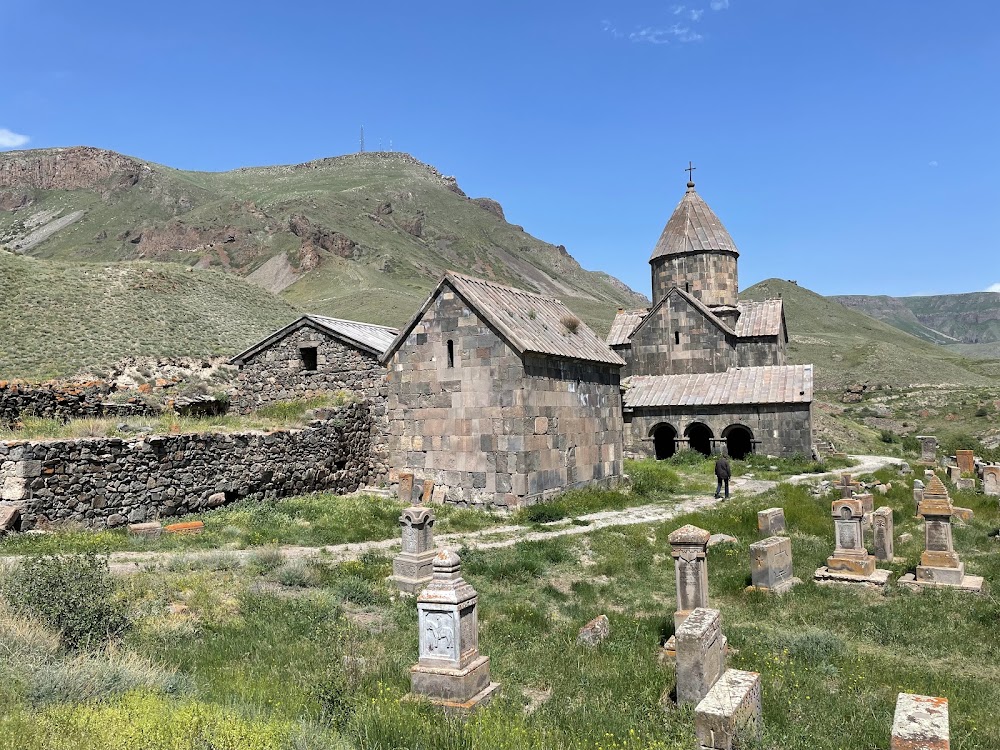Vorotnavank Monastery (Վորոտնավանք)
Overview
Vorotnavank Monastery, a hidden gem nestled in the Syunik Province of Armenia, offers an unparalleled glimpse into the country’s rich cultural and religious history. If you're planning a visit to Armenia, make sure this extraordinary site is on your itinerary. Located about 4 kilometers southeast of the village of Vorotan, the monastery stands majestically on a picturesque hill, providing breathtaking views of the surrounding mountains and valleys.
Historical Significance
Founded in the 10th century by Queen Shahandukht, the mother of King Smbat of Syunik, Vorotnavank holds great historical significance. Initially serving as a fortress, it gradually evolved into a major religious and cultural center. The monastery complex comprises several buildings, with the most notable being the Church of St. Gregory the Illuminator and the Church of the Holy Mother of God. Both structures exemplify Armenian medieval architecture, showcasing intricate stone carvings and unique architectural styles.
Architectural Marvels
The Church of St. Gregory the Illuminator, built in 1000-1001 AD, is the older of the two churches. Named after the patron saint of Armenia credited with converting the country to Christianity in the early 4th century, this church has weathered numerous challenges over the centuries, including invasions and natural disasters. Despite this, it retains its ancient charm and spirituality, making it a site of pilgrimage for many.
Adjacent to it, the Church of the Holy Mother of God was constructed in 1006 AD. This church stands out with its distinctive architectural features, including a dome supported by a rectangular base—a rarity in Armenian church designs. The interior captivates with remnants of beautifully frescoed walls, offering a glimpse of its former grandeur. Historians believe it was one of the few churches in the region that housed ancient manuscripts and served as an educational center.
A Symbol of Resilience
Vorotnavank Monastery is not just a spiritual refuge but also a symbol of resilience. It has been destroyed and rebuilt multiple times over the centuries. Notably, it suffered significant damage during the 1931 earthquake but has since been restored, ensuring that its historical and architectural legacy continues for future generations. Ongoing efforts to maintain and restore this invaluable heritage site make it a living monument to Armenia's enduring faith and culture.
Whispers of the Past
When you visit Vorotnavank, you are not merely stepping into a historical site; you are entering a world rich with stories of the past. The walls, some partially ruined, seem to whisper tales of monks, kings, and invaders who have walked these grounds. The monastery’s layout reflects strategic planning typical of a fortress, with high defensive walls and lookout points offering spectacular panoramas—a perfect opportunity for photography enthusiasts.
Intriguing Khachkars
Another captivating aspect of the monastery complex is its khachkars, or Armenian cross-stones, scattered throughout the site. These intricately carved stones, some dating back to the medieval period, are unique to Armenian culture and are considered expressions of faith, art, and craftsmanship. Each khachkar tells a story; observe the details closely to see depictions of crosses, biblical scenes, and intricate geometric patterns.
Exploring the Surroundings
For those interested in exploring further, the beautiful Syunik Province is rich with natural wonders and other historical landmarks. The nearby Vorotan Gorge is perfect for hiking and outdoor activities, offering an opportunity to marvel at Armenia’s rugged landscape. Additionally, the Tatev Monastery, another architectural marvel, is within easy reach and can be included in your day trip, enhancing your travel experience.
Planning Your Visit
Visiting Vorotnavank requires some planning, as it is located in a somewhat remote area. However, the effort is well worth it. Whether you choose to hire a guide or explore on your own, make sure to allocate enough time to soak in the serene atmosphere and the historical richness of the site. The local villagers are often very hospitable and can share insights and stories that you won't find in guidebooks.
In conclusion, Vorotnavank Monastery stands as a testament to Armenia’s resilient spirit, rich history, and architectural genius. It is a place where the past comes alive, offering visitors a deeply enriching experience that transcends mere sightseeing. If you are a lover of history, architecture, or simply beautiful landscapes, Vorotnavank Monastery is a destination that will undoubtedly leave a lasting impression.



